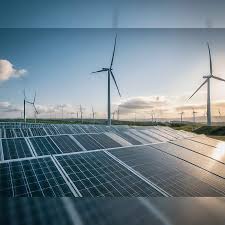🌞 Introduction
India is undergoing a clean energy transformation, with an ambitious goal of achieving 500 GW of non-fossil fuel capacity by 2030. As of 2025, the country has made significant strides in solar power, wind energy, and green hydrogen, positioning itself as a global leader in the fight against climate change and energy insecurity.
⚡ Current Clean Energy Landscape in India
- Renewable Energy Installed Capacity (2025): Over 180 GW, including:
- Solar: ~85 GW
- Wind: ~50 GW
- Hydro & Biomass: ~45 GW combined
- Clean energy now contributes to more than 40% of India’s power generation capacity.
- India ranks 3rd globally in renewable energy additions, after China and the US.
☀️ Solar Power: The Flagship Sector
- Government schemes like PM-KUSUM and Solar Park Development have expanded utility-scale and rooftop solar.
- Falling panel costs and PLI schemes (Production Linked Incentives) have made solar affordable and scalable.
- India’s sunny geography gives it one of the highest solar potentials globally.
- Residential and commercial rooftop solar installations are booming in cities like Delhi, Pune, Ahmedabad, and Hyderabad.
🌬️ Wind Power: Offshore and Onshore Growth
- New onshore wind farms in Tamil Nadu, Gujarat, and Maharashtra.
- India’s first offshore wind energy projects underway in Gujarat coast (1 GW planned).
- Improved turbine efficiency and better forecasting tools are helping wind become a reliable base load.
🧪 Green Hydrogen: The Next Big Leap
- Under the National Green Hydrogen Mission, India aims to produce 5 million tonnes of green hydrogen annually by 2030.
- Green hydrogen is produced using renewable electricity and electrolysis, replacing grey hydrogen made from fossil fuels.
- Major industrial players like Reliance, Adani, and NTPC are investing heavily in hydrogen hubs.
- Green hydrogen will revolutionize sectors like:
- Steel & cement (clean industrial fuel)
- Heavy transport (trucks, ships)
- Fertilizers (replacing ammonia derived from natural gas)
🔄 Storage, Grids, and Battery Innovation
- India investing in grid-scale battery storage and pumped hydro systems to manage intermittency of solar/wind.
- Domestic manufacturing of Li-ion batteries under PLI schemes.
- Smart grid initiatives being rolled out to enable better energy distribution and load balancing.
🌱 Environmental & Economic Benefits
- Major cut in CO₂ emissions and reduction in fossil fuel imports.
- Thousands of new jobs in solar panel manufacturing, installation, and maintenance.
- Rural electrification boosted through mini-grids and solar microgrids.
- India’s clean energy shift is critical to achieving its net-zero target by 2070.
🧠 Final Thought
India’s clean energy momentum in 2025 is a beacon for the world. With the right policy push, tech innovation, and global cooperation, India is not just reducing its carbon footprint—it’s leading the global energy revolution.
































































